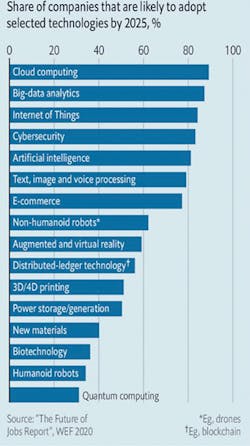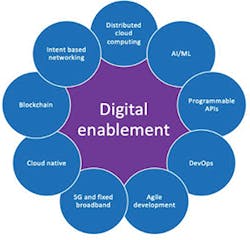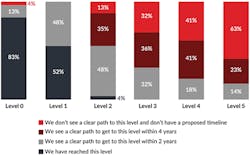Latest from Network Transformation/Edge Compute/IoT/URLLC/Automation/M2M
Autonomous Networks on Steroids
Why Industry 4.0 Can’t Survive Without Them —
Network automation is not new, but the level of automation (full automation) is now possible in the telecom infrastructure and is a major enabler of Industry 4.0.
Sure, digital transformation has been a major trend across most industries over the past few years. Companies and organizations of all sizes and across many industries have initiated major moves toward automation, the adoption of data as driver for processes and business models, the use of distributed computing, IoT, and other technologies. At the same time, they have started rethinking their organizations to align them around a digitally enabled infrastructure.
Despite their best efforts, the response has been uneven and for the most part suboptimal, because the tools that these businesses have are inadequate. For example, operators have increased capacity in the Last Mile by sending technicians to add physical network components, and often had to supplement these systems with additional hardware racks in their central operating locations. Although this met the short-term need, it is expensive and totally nonelastic. If utilization decreases in the future, the added capacity will be underused, resulting in stranded capital.
Companies in all industries need much better digitally enabled business models and are now rushing to define and implement those business models at an astonishing rate. A recent survey by the World Economic Forum found that 80% of companies intend to digitize their processes; a study by the Economist highlights the type of technologies firms will be implementing. (See Figure 1.)
Figure 1. Adoption of Digital Technologies (1)
The rate of transformation is also unprecedented. A recent study by McKinsey, for example, showed that "increasing the use of advanced technologies in business decision-making" takes 25.4 days, compared to the 635 days it takes in normal times.(2)
CSPs have been delivering the technologies and associated services to enable the transformation to digitization.(2)
• Scalable cloud infrastructures
• Edge compute resources
• IoT
• Blockchain
• Automated networks
• Real-time visibility
However, to realize the full promise of Industry 4.0, a communication infrastructure must provide the underlying framework for these technologies; this framework is Autonomous Networks.
What’s Needed
As they accelerate their digital transformation, companies in all industries will demand new services and capabilities from their suppliers and vendors. At the forefront are the service providers that deliver the underlying connectivity, hosting, and compute infrastructures, that will provide the underlying infrastructure inherent to the digital firm. Cloud and edge computing, the secure and fast transport and processing of big data, IoT enablement, the delivery of Virtual Reality and Augmented Reality capabilities, cybersecurity, blockchain, and others, are some of the capabilities the service providers need to deliver at scale, with high reliability, velocity, elasticity, and flexibility, in the near future. (See Figure 2.)
Figure 2. CSP Digital Enablement
Delivering these capabilities and others will not be possible with manual, siloed infrastructure. Although it is true that CSPs have started implementing software-based infrastructures, and many have introduced automation capabilities across their networks and operating environments, the scale and complexity of what Industry 4.0 will require far exceeds the capabilities of most, if not all, CSPs today. (See Figure 3.) A new framework is required: this framework relies on pervasive intelligence and automation; it demands a communication and an operating infrastructure that is a fully automated network that is self-healing, self-managing, and fully reliable.
Figure 3. CSPs’ Progress on Automation (Source: TM Forum 2020)
Network automation is not a new concept, and most operators have already implemented some level of automation in their networks and operating environments. However, the level of automation currently in place is inadequate for the requirements of the market going forward. It is increasingly obvious that the market needs a much more comprehensive and pervasive level of automation in network infrastructure powered by intelligence implementation. The new level of automation must handle closed-loops as well as the capability to support full-cycle automation, enabled by AI This level is referred to as Autonomous Networks (AN).
ANs are becoming an essential goal for every CSP, and will be table stakes for success in a fast-transforming market as they become the bedrock of digital industries. Today, operators are in a better position to move toward AN:
• Market forces are making AN essential, and the pace of change is creating business opportunities for CSPs to grow revenue by offering end-to-end services across verticals.
• Many of the impediments to achieve AN are being mitigated by advances in technology.(3)
Although each vertical has its own ecosystems, operating goals and KPIs, applications, and customer needs, an underpinning requirement is the gathering and storage of data, the reliable movement of that data, high speeds over a versatile communication infrastructure, and the ability to dynamically adapt to changes in the business environment.
Achieving the promise of Industry 4.0 requires a complete transformation of the enterprise toward a digital operating model where employees design and oversee a software-automated, algorithm-driven digital organization that actually delivers the goods.(4) At the heart of this enterprise is an AI factory that provides the underlying capability for data gathering, analytics, and decision-making. This organization is modular or composable; it requires a new communication infrastructure that enables modularity, flexibility, scalability, and velocity.
ACG Research has recently defined the concept of Intelligent Composable Fabric, which contains operations, information, and communications technology modules that flexibly compose the intelligent digital operations platform of an enterprise.(5) (See Figure 4.) This fabric requires a communication infrastructure that is zero wait, zero touch, and zero trouble (Zero X). Such an infrastructure can be delivered only by autonomous networks.
Figure 4. Vision of Autonomous Networks (Source: TM Forum, 2020)
Although there are multiple levels of automation, the truly digital enterprise is realized only at the maximum level of automation or full automation where the system possesses closed-loop automation capabilities across multiple services, multiple domains, and the entire life cycle. Only in this case can Zero X be realized.
At the heart of autonomous networks are autonomous domains that form the basis for closed-loop automation. They expose network capabilities that can be used by the enterprise without exposing the complexity, enabling the enterprise to define business rules and to use the capabilities as needed and when needed by the business on a modular level. These capabilities are self-assuring, providing maximum reliability to the business.
As AI becomes the run time of the digital enterprise of the future, the firm will be rearchitected to leverage the power of data, networks, and AI. This is possible only when the underlying network infrastructure delivers the resiliency, scalability, and automation, that is enabled by autonomous networks.
InvisiLight® Solution for Deploying Fiber
April 2, 2022Go to Market Faster. Speed up Network Deployment
April 2, 2022Episode 10: Fiber Optic Closure Specs Explained…
April 1, 2022Food for Thought from Our 2022 ICT Visionaries
April 1, 2022The Promise Realized
The COVID-19 pandemic ushered a digital acceleration on an unprecedented scale and scope. Although some of the changes were short-term-focused, meant to blunt the impact of the pandemic, the crisis has caused leaders in every industry to rethink their business models, with digital enablement front and center to their strategies.
Digital enablement is the foundation of this transformation, and this foundation has to be powered by a network that is autonomous, ultra-fast, extremely reliable, flexible, and highly scalable. That autonomous network is the only route to achieve this transformation because it enables the diversity, agility, dynamic scalability, and security requirements, of Industry 4.0.
Now is the time for the autonomous network, which is not simply the next thing — it is essential to enabling the world to deal with shocks, to deliver the dynamism that will be needed in every industry going forward.
The business conditions are ripe, but the technology has also evolved to a point where this premise is now possible and, indeed, realizable. Innovative CSP vendors are already introducing AN solutions, and CSPs are beginning to draw plans with their vendors and partners to evolve their technology and business models to make autonomous networks a market reality.
References and Notes
1. Figure 1, Adoption of Digital Technologies, source: https://www.economist.com/finance-and-economics/2020/12/08/the-pandemic-could-give-way-to-an-era-of-rapid-productivity-growth?utm_campaign=the-economist-today&utm_medium=newsletter&utm_source=salesforce-marketing-cloud&utm_term=2020-12-08&utm_content=article-link-1&etear=nl_today_1.
3. https://acgcc.com/media/reports/files/ACG-Autonomous_Networks_Now_is_the_Time_Article_Dec2020_1.pdf
4. "Competing in the age of AI," Marco Iansiti, Karim R. Lakhani, Harvard Business Review Press.
5. Paul Parker-Johnson, ACG Research private conversation, December 2020
This article is adapted from an ACG Research white paper; it can be found at https://acgcc.com/reports/autonomous-networks-power-industry-40/.
For more information, please email [email protected] or visit http://acgcc.com/. Follow Offredo-Zreik on Twitter @offredo.
Like this Article?
Subscribe to ISE magazine and start receiving your FREE monthly copy today!

Liliane Offredo-Zreik | Principal Analyst, ACG Research
Liliane Offredo-Zreik is a principal analyst with ACG Research. Her areas of coverage include the cable industry, SD-WAN, and digital transformation. Prior to her analyst work, she held senior roles in major telecom and cable companies, including Verizon and Time Warner Cable (now Charter).
Thank you to Liliane’s ACG colleague, Mark Mortensen, for his significant contributions to the original paper and ACG Research’s, “Autonomous Network Power Industry 4.0”.
For more information, please email [email protected] or visit www.acgcc.com.
Follow Liliane on Twitter: https://twitter.com/offredo and LinkedIn: https://www.linkedin.com/in/lilianeoffredozreik/.
Follow ACG Research on Twitter: https://twitter.com/acg_r/ and LinkedIn: https://www.linkedin.com/company/acg-research/.











